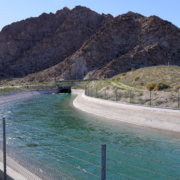The California Water Commission is holding public workshops as part of its efforts to assess a potential state role in financing conveyance projects that could help meet needs in a changing climate. A workshop in Southern California is scheduled for December 10 on Zoom.
The Commission’s goal with the workshops is to hear from diverse voices across the state. Participants from the region are encouraged to share their perspective on conveyance projects, conveyance infrastructure needs and priorities. The Commission also wants to learn about effective partnerships, public benefits of conveyance, possible criteria to assess resilience, efforts in preparing for changing hydrology, and effective financing mechanisms.
“As water managers, we are constantly refining strategies to meet the challenges of the future, and local and regional water conveyance is one of our most significant tools,” said Sandra L. Kerl, general manager of the San Diego County Water Authority. “It’s important that we come together to advance integrated conveyance and interconnectivity solutions in light of the changing climate so that we can enhance regional water supply resilience for generations to come.”
The workshops are not associated with the pending proposal to improve conveyance through the Sacramento-San Joaquin Delta.
Public workshops on water conveyance projects; funding options in Colorado River and South Lahontan region
The first workshop will focus on Southeastern California, including the Colorado River region and the Mono, Inyo and San Bernardino County region. The Southeastern California regional workshop will be co-hosted by the Imperial Irrigation District and the San Diego County Water Authority.
Water management issues and climate change
The workshops will be conducted via the web-based videoconferencing service Zoom. More detailed instructions on how to use Zoom and participate in the meeting can be found on the Commission website.
Additional workshops will be centered on Southern, Northern and Central California.
The nine-member California Water Commission uses its public forum to explore water management issues from multiple perspectives and to formulate recommendations to advise the director of the California Department of Water Resources, and other state agencies including the California Natural Resources Agency, on ways to improve water planning and management in response to California’s changing hydrology.
Workshop Schedule
All workshops are from 2:45-5 p.m. (entry to meeting site opens at 2:30 p.m.)
Southeastern California (Colorado River, South Lahontan) – Tuesday, December 8, 2020 (registration open now)
Southern California – Thursday, December 10, 2020 (registration open now)
Northern California – Tuesday, January 12, 2021 (registration open December 14, 2020)
Central California – Tuesday, January 26, 2021 (registration open December 14, 2020)




